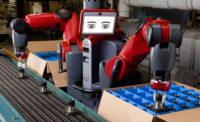Rethink Robotics Returns to the Manufacturing Marketplace

The Reacher line of cobots comprises seven models with payload capacities of 15 to 66 pounds and a maximum reach of 800 to 1,600 millimeters.
Photo courtesy Rethink Robotics
Remember Rethink Robotics? The company was co-founded by Rodney Brooks and Ann Whittaker in 2008. Before starting the company, Brooks was a professor of robotics at the Massachusetts Institute of Technology and former director of the MIT Computer Science and Artificial Intelligence Laboratory. He was also the founder and former chief technical officer of iRobot, the maker of the Roomba home vacuum-cleaning robot.
Rethink was launched with the aim of creating low-cost, easy-to-use robots. The company made a splash in 2011 when it released Baxter, a two-armed collaborative robot with an animated face. Three years later, the company released a smaller, more flexible model, Sawyer, a one-armed cobot for smaller, more detailed tasks.
Although Rethink was among the first companies to commercialize cobots for manufacturing, it was quickly overwhelmed by competition from mainstream robotics companies, including ABB, FANUC, KUKA, Comau, Stäubli and Universal Robots. Despite a lot of hype, sales of Baxter and Sawyer never took off, and the company closed in 2018. It’s tough to be a start-up!
But, like a phoenix rising from the ashes, Rethink Robotics surprised everyone by reappearing at this year’s International Manufacturing Technology Show in Chicago last month with a large booth. The company displayed three new robots it says are better designed for manufacturing.
One of those new robots is Reacher, a conventional-looking six-axis cobot. The Reacher line comprises seven models with payload capacities ranging from 15 to 66 pounds and a maximum reach of 800 to 1,600 millimeters. The robots have an IP65 rating for use in wet and dusty environments, and they have a positional repeatability of ±0.03 millimeter, making them suitable for the most demanding tasks. Depending on the model, maximum speed ranges from 120 to 200 degrees per second.
Another new product is the Rider line of autonomous mobile robots, which can navigate independently through a factory without the need for external components. Two models are available. The light-duty MRE 550 model handles payloads of up to 1,212 pounds, and the heavy-duty MRE 1400 model handles payloads of up to 3,086 pounds. Both robots come with an integrated lift function. The robots have 360-degree sensing ability for analyzing and responding to real-time changes in the environment.
Low-level controllers and sensor data are accessible through open architecture software compatible with third-party applications. A simultaneous location and mapping system provides environmental visualization for pallet identification, dynamic obstacle bypassing, and trajectory planning.
A third new product, the Riser mobile manipulator robot, combines the Reacher and Rider products to create a cobot that can move from application to another. The Rider moves the Reacher to wherever it’s needed. Both robots are powered by their own battery packs. The combined systems is designed for intermittent pick-and-place operations and machine tending applications where cycle times are relatively long, making it difficult to justify the purchase of a dedicated cobot for each station.
To be honest, I never thought much of Baxter. I remember touring an assembly plant in 2017 and seeing an unused Baxter tucked away in the corner. When I asked the plant manager about it, he conceded that his team could never quite find a good application for it. Maybe it was the animated face that bothered me. The robot seemed more like a toy than an industrial machine.
Rethink’s new portfolio seems more mature, straightforward and targeted at manufacturers.
We welcome the return of Rethink Robotics, and we wish the company the best of luck. The company’s timing is certainly auspicious, since demand for cobots shows no sign of slowing down. Indeed, according to ASSEMBLY’s annual Capital Equipment Spending Survey, 42 percent of assemblers—a record high—are currently using cobots or plan to by the end of the year. Another 15 percent expect to deploy the technology in the next two to three years.
Let’s hope Rethink’s second go-round lasts longer than the first!
Looking for a reprint of this article?
From high-res PDFs to custom plaques, order your copy today!





